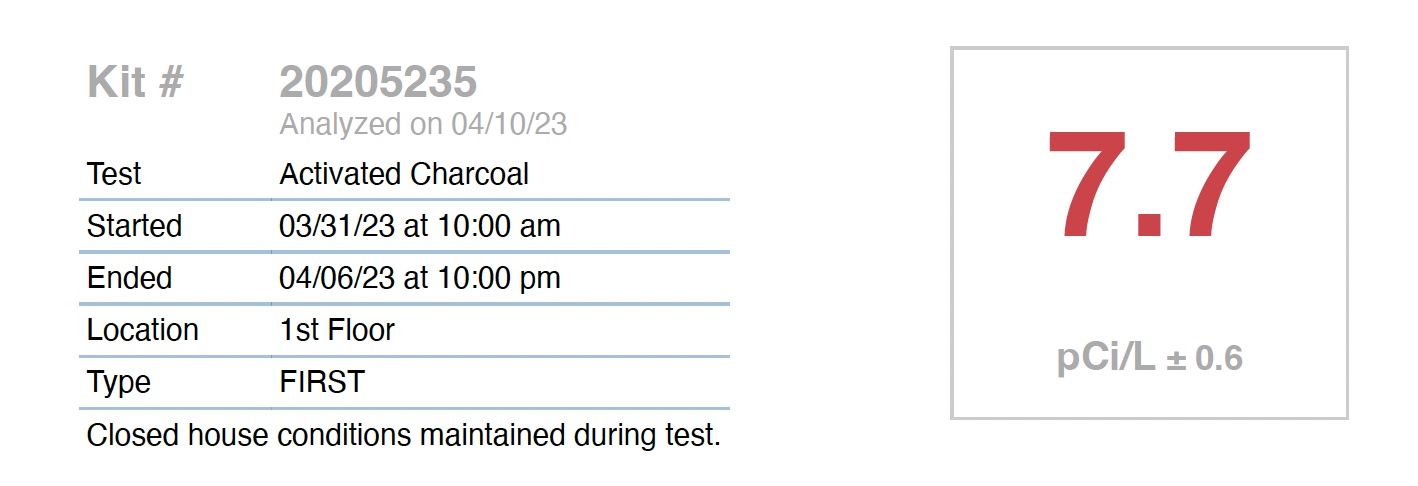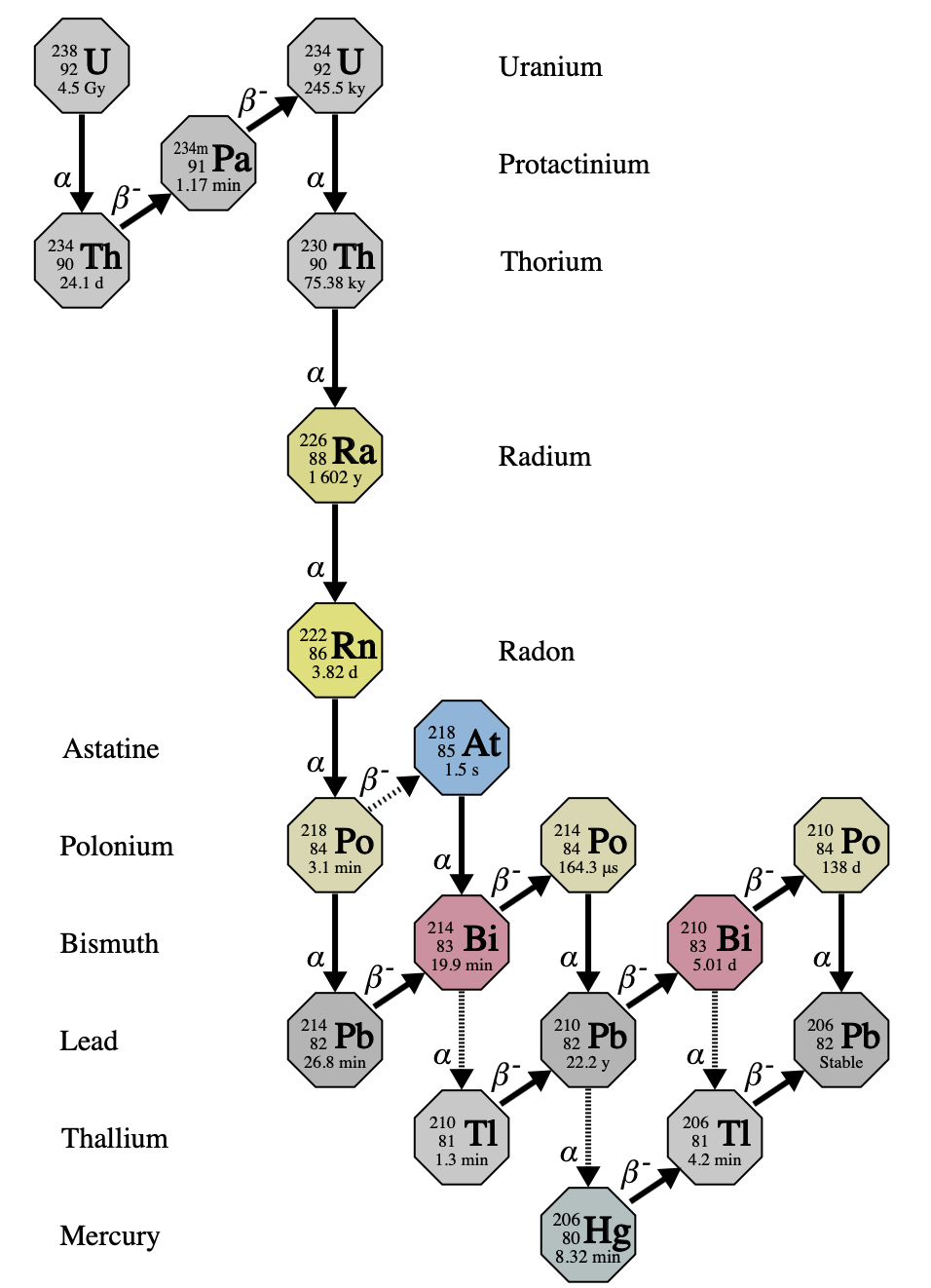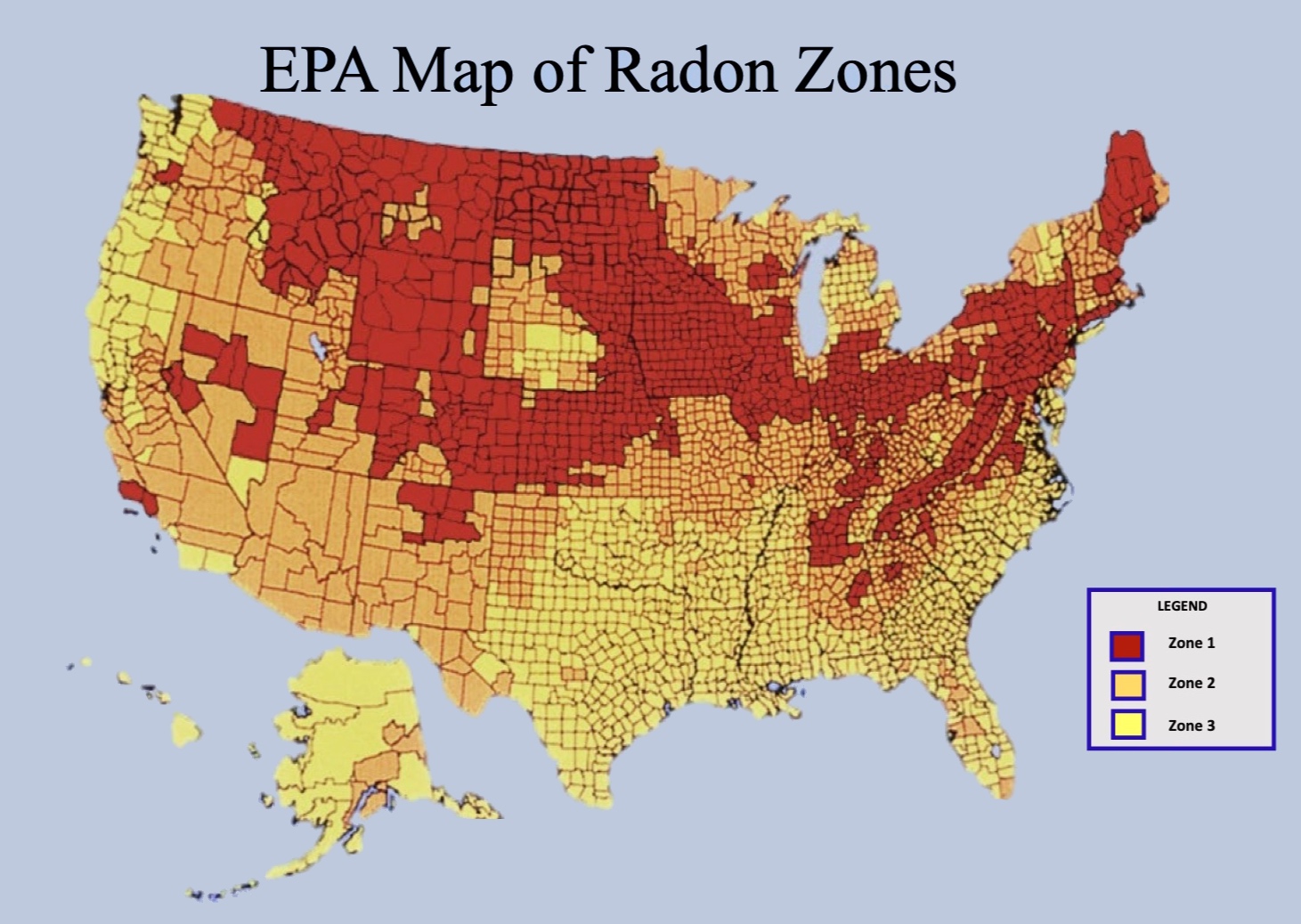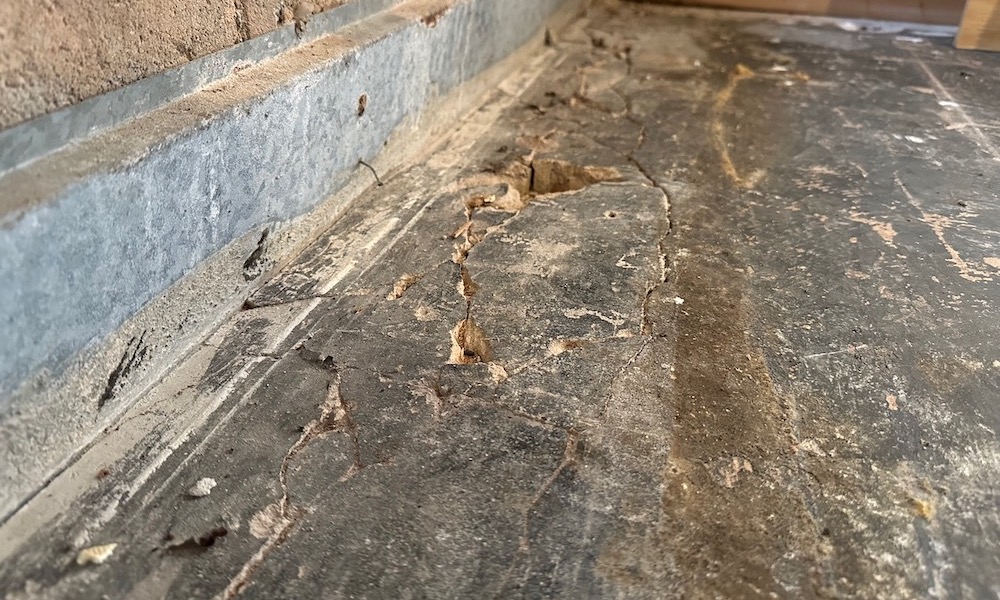What to Know About a High Radon Test Result
![How Radon Enters A Home [US EPA]](https://www.energyvanguard.com/wp-content/uploads/2023/04/how-radon-enters-home-epa.jpg)
I got a high radon test result for my house this week. I’ve lived in the house nearly four years now and finally got it tested. Yay! The result is high. Boo! But what does it really mean? I haven’t written about radon here yet, so let’s have a look.

Radon basics
Radon is a noble gas on the far right side of the periodic table of the elements. I’m sure you know them by heart: helium, neon, argon, krypton, xenon, radon, and now, apparently, a new one named oganesson. But it’s not radon’s association with the formerly-called inert elements that makes it of interest in the field of indoor air quality. It’s its ability to get into our lungs and cause lung cancer through radioactive decay.
Radon is a radioactive element in the decay chain of uranium-238, which is in granite and some other types of stone. We have a lot of granite here in the Atlanta area. You may have heard of Stone Monadnock? Most people call it Stone Mountain, and it’s solid granite.

The problem isn’t completely radon, though. The radon does bring the radioactivity into your house when it seeps in from the soil beneath. It floats around in your indoor air, decaying into other radioactive atoms fairly quickly. It’s half-life is 3.8 days.
Radon decays by emitting alpha particles, which are just helium atoms with no electrons. Alpha particles can cause a lot of damage to lung tissue. They cause even more when the radioactive atom emitting them is attached to the lung tissue.

That’s what the progeny (decay products) of radon do. They’re electrically charged, so they stick to the alveoli in the lungs. The decay products polonium-218 and polonium-214 are believed to cause most of the lung cancer from houses with high radon levels.
Why test for radon?
The US EPA has created a map of radon zones in the United States (image below). It shows you the areas where you’re more likely to have high radon levels. Every county and parish is labeled either zone 1, 2, or 3. Zone 1 means you have the highest chance of a high radon level in your home. Zone 3 is the lowest.

The thing is, that map doesn’t tell you what’s happening with radon in any particular building. You can live on a whole street full of homes with low radon levels, but yours still could be high.
Even in a Zone 3 location, you could have high radon levels. The state of Georgia keeps records on radon test results. Chatham County, Georgia, where Savannah is, shows up as Zone 3 on the EPA map. The highest level recorded in that county is 49.7 picoCuries per liter (pCi/L). That’s really high. (See the Georgia radon results map for more.)
You don’t know unless you test. And if you don’t test, you could become one of the 21,000 people who die of lung cancer each year from long-term exposure to high radon levels.
Understanding the result
Let’s discuss units first. I’ve mentioned picocuries per liter already, abbreviated pCi/L. A curie, named for Pierre and Marie Curie, represents 37 billion radioactive decays per second. If that sounds bad, it’s because it is.
And that’s why we’re talking picocuries. A picocurie is one trillionth (10^-12) of a curie, so that makes it 0.037 disintegrations per second. When you put the “per liter” on it, that makes this unit a concentration. It tells you how much radioactive radon fills the air in your home.
The outdoor concentration of radon, according to the US EPA, is about 0.4 picocuries per liter. And the EPA gives guidance on when you should do something about indoor radon levels. They say you should definitely work on the house to reduce the radon level if it’s above 4 pCi/L and probabably mitigate if it’s between 2 and 4 pCi/L.
Here’s a table from the EPA showing the risk to people who have never smoked.
![Radon risk for people who have never smoked [from US EPA]](https://www.energyvanguard.com/wp-content/uploads/2023/04/radon-lung-cancer-risk-never-smoked.png)
As you might expect, smoking increases your risk significantly. For example, at 4 pCI/L, about 4 never-smokers might get lung cancer but the number rises to 62 for smokers.
In some places, radon levels are measured in bequerels per cubic meter (Bq/m^3) instead of pCi/L. The conversion factor is 1 pCi/L = 37 Bq/m^3. So 4 pCi/L would be 4 x 37 Bq/m^3 = 148 Bq/m^3.
What to do after a high radon test result
Now, in my case, our first test resulted in a radon level of 7.7 pCi/L. That’s definitely above the 4 pCi/L action level. It doesn’t surprise me that it’s high because we’re in radon zone 1. And my basement, which I’m slowly renovating, has plenty of ways for radon to get in. The photo below shows part of my basement slab, and those cracks aren’t isolated to this one spot.

The radon level in our home is far from the highest recorded in Dekalb County. According to that Georgia radon map, the highest they’ve recorded is 95.6 pCi/L, and about 18 percent of homes tested here have elevated levels.
The other important factor here is that I’ve done only one short-term test. Radon levels fluctuate with all kinds of factors, including the weather. We did have a day with 1.8 inches of rain, so that probably bumped it up some. When you do a single short-term test, the best thing to do is first, don’t freak out. As I understand it, lung cancer from radon takes exposure over many years. So, first, do a follow-up test.
The test kit I used is meant to be left open in the house for 3 to 7 days. There are also long-term tests that you leave for 3 to 12 months. The long-term number will give you a better idea of your true exposure. I’ve got a couple of those, too, and will be setting one out this week to get it started.
My next steps are to continue working on my basement and getting it sealed up. Those cracks in the slab and other places that allow soil gases into the house are a radon liability.
Radon resources
The first place to go is the US EPA radon page. There’s a ton of information there, including where to get radon test kits, a downloadable copy of the US radon zone map, and a lot more. They also have a page with links to radon hotlines, programs, and training. Your state may have good resources, including free or subsidized test kits. Here’s the radon page for Georgia. For basic information as well as detailed science, the radon page on Wikipedia is great.
Now, get your house tested. If the radon level is high, test again and start the process of getting it fixed. I’ll come back and write about the important step of radon mitigation later. For now, see the EPA resources above.
Followup article: Does Radon Really Cause Lung Cancer?
Allison A. Bailes III, PhD is a speaker, writer, building science consultant, and the founder of Energy Vanguard in Decatur, Georgia. He has a doctorate in physics and is the author of a popular book on building science. He also writes the Energy Vanguard Blog. For more updates, you can subscribe to our newsletter and follow him on LinkedIn.
Related Articles
Does Radon Really Cause Lung Cancer?
A Layered Approach to Indoor Air Quality
4 Ways a Bad Duct System Can Lead to Poor Indoor Air Quality
The 2 Main Problems With Kitchen Ventilation
Comments are moderated. Your comment will not appear below until approved.
This Post Has 23 Comments
Comments are closed.

I’d like to see the smart people (like you, Allison) take a more critical approach to assessing the risk that radon poses. Every time I see these discussions come up, the EPA is used as the primary (or sole) source of info. I never see the source of the EPA’s data being discussed or critiqued.
The EPA’s risk estimates (21K deaths per year) is scary indeed. But the studies that these figures come from are decades old and are arguably of questionable validity. Did you know that these studies are based on radon exposure in miners working underground, not the general population living in houses? I think it is important to note that newer studies have often found no relationship between residential radon exposure and cancer. And there are even some studies that find a *negative* relationship between radon exposure and cancer. IMO, the evidence is far from clear.
What is more clear to me is the financial incentive that is associated with radon mitigation. In my area, radon gas levels are very low. Despite this, there is a booming radon mitigation industry. Somehow, the radon mitigation companies always seem to find an urgent need to install expensive equipment to save homeowners from an invisible and odorless yet lethal gas.
I am not making any definitive claims about the risk that radon poses to homeowners. I’m just saying that it doesn’t appear to be as clear as the EPA makes it out to be. I hope some of the building science nerds will dig into the radon data and be as critical as they are about other areas of building science practices. It is quite possible that homeowners would be better served by spending radon mitigation money on energy retrofits or IAQ improvements.
Thank you for bringing this up. My impression is that the health concern has proceeded without sufficient contemporary analysis, exactly as you indicate, and the scaremongering benefits the growing number of sellers of (now-obligatory) radon mitigation at exorbitant prices. The field of BS (!) should give this a good hard look and its own conclusions.
I have to side with Ken on this topic. I was a graduate student in the early 1980’s and took a course on IAQ. As part of that course, I had to do an independent literature survey and report on an IAQ topic. I chose radon because it was a relatively new concern at that time. What I found out was that there was good solid data on cancer incidences for uranium miners that were exposed to much higher levels of radon that cited in this blog. The researchers then did a linear extrapolation of the cancer rates that would be expected to occur at the lower rates shown in the table above, even though they had no data in that range. I wish I had the actual data handy for this mining study to show how much extrapolation was done.
A few years later, 60 Minutes did an episode discussing this issue and how it resulted in a radon testing and mitigation industry that many feel experts believe is unnecessary.
I have read other articles by scientists who point out that almost every substance is dangerous at high exposures, but that at low exposures there is typically no effect at all. In fact, low doses of some substances actually make you strong because your body builds immunity. I am not claiming that radon falls in this category, but I haven’t seen any data indicating that it doesn’t either.
I had a house in New York in a high radon area and when I put it up for sale a prospective buyer wanted it tested for radon first. I told him to just assume that it was high and take the cost of a radon mitigation system into account when you make your offer.
I just don’t trust EPA on this issue, but that is just my opinion.
100% accurate. When I bought my house in MA I spent hours trying to find real homeowner data for radon deaths and only found inferences from miners exposed to very high levels.
I’ve never seen data of non-smoker homeowners dying from radon in their house.
Scaremonger contractors push expensive remediation based off industrial mining data.
Allison, thank you for posting this. My first reaction to this would be that 7.7 pCi/L isn’t that bad considering the types of cracks in your slab (and it’s only one photo). That is not to say that 7.7 pCi/L isn’t an action level, it is. Just saying, your basement slab appears to be in the sieve category of slabs.
For new construction (single family), my overall strategy is: (a) assume it’s there, (b) provide pressure relief pathways under the slab and behind basement walls, (c) seal.
A 4″ PVC vent pipe connected to underslab branches is part of (b). That 4″ vent can remain a passive vent, and, if testing reveals the need, a mechanical vent will be attached.
What causes the radon to exit out that vent? I assume the air under the slab is colder than outside so it will not rise up the PVC pipe.
Cody, in a mixture of gases, each gas has its own pressure property. In a passive setup, that pipe is an open pressure relief valve.
I would like to add to the above that, for new construction, doing the few preemptive steps with radon in mind makes for a better quality and more resilient construction, regardless of one’s belief or doubts about radon. We end up better controlling not just radon, but other common soil gases such as water vapor, carbon dioxide (CO2), methane (CH4), nitrous oxide (N2O), and ammonia (NH3) [multiple sources].
I don’t think exclusively about radon when I specify a minimum 10 or 12-mil vapor barrier under the basement slab (rated for long-term exposure to the alkaline environment of the concrete on top of it). Same for the gravel layer under the slab. Same for the drainage mats on outside of basement walls connected to footing drains.
I have been using an Airthings radon detector in my basement since last year. It is not that expensive and saves the cost of test kits and mailing.
Readings matched pretty closely to the numbers I got four years ago with a test kit, at 1.4 pC/l. I have now lent it to a friend to monitor their basement in anticipation of an elderly relative moving in.
When the house was built code only required a simple T fitting under the slab, which I thought inadequate. So, I added perforated pipe the length of the basement slab and under the plastic in the conditioned crawlspace (in a bed of gravel to allow air to move more freely to the pipe).
Without a control, I can’t say it helped, but I am happy with the result given I have a lot of granite like Allison in Greenville, SC.
I bought the Airthings as well to monitor pm2.5 and radon. Now have over a year’s worth of data. Was well worth the money spent.
I have an Air Pura air purifier that runs on low 24 hours a day, except when Pm2.5 starts rising (usually its under 2 on low). Highest was 21 during Canada smoke. Airthings alerted me and purifier went to high and dropped it down to 5-7.
Had a couple days where radon was over 4 for a an hour or two. Average over nearly 1.5 years is under 2.
Hi Allison,
I am a long time lurker, first time poster. This article is the article that motivated me enough to post, I love how you present the information. And how necessary it is, keep up the great writing and spreading knowledge.
Hey Big Al:
Central Kentucky is ALL limestone and granite. Runs down through the middle of Tennessee.
Previous owner and builder lost his wife to lung cancer (about 15 year exposure to 9.4 pCl.) in the basement before air conditioning. House was a “Gold Medallion” (all electric home 1950’s–1960’s).
None of the new builders test for Radon but rather the new owner, after taking my class, actually test !!
Nice article – Thanks
Dr. WC (Bill) Goetz, PhD, EdD, CSHM
Great, informative article. As a resident of central PA, I live in the heart of radon country.
When building a new home, especially in colder climates, sub-slab insulation is required by current energy codes. One consideration for insulation below a slab is the application of closed-cell spray foam. Not only does SPF provide the requisite R-value, it also air-impermeable, sealing the infiltration of soil gases into the basement areas. Closed-cell SPF has been approved in Canada as a radon barrier for several years. Just a thought for new contruction.
What is missing in the table included in this article is the cumulative impact of length of exposure. For example, it says that at 4 pCi/L the risk is similar to that of dying in a car crash. Does that mean that – if I live in this house for just one day – then the risk that I’ll eventually die of cancer from just this one day of exposure is similar to the risk that I’ll die in a car crash during just one (normal) day of driving? And similarly for one year of exposure – if I live in this house for just one year – then my risk of eventually dying of cancer from just this one year of exposure is similar to the risk that I’ll die in a car crash during just one (normal) year of driving?
Galen: If you read the heading of the second column, it says: “If 1,000 people who never smoked were exposed to this level over a lifetime*…” So, no, it’s not one day of exposure. It’s cumulative exposure over a lifetime. As with smoking, the longer you’re exposed, the greater your risk.
The footnote gives the reference, an EPA document based on the National Academy of Sciences study, Biological Effects of Ionizing Radiation VI. You can download the EPA document with this URL:
https://www.epa.gov/sites/default/files/2015-05/documents/402-r-03-003.pdf
Per the EPA estimates only 2900 deaths occur annually in non-smokers. A minuscule percentage of the entire population.
I wonder what the death rate is for other toxic gases and mold that infiltrates basements.
It would seem to me money would be better spent on contolling over infiltrations than on an expensive radon mitigation system.
Allison, why do pretty much all radon mitigation systems include vents going up? Radon, at 9.9kg/m3 is about 8 times heavier than air. For a 2-story house, that’s a lot of lifting. Yes, EPA says to keep it away from kids on the ground, and because of “the potential for re-entrainment of the gas into the house”. Would it be easier to re-entrain into the house from a ground level discharge or from a roof-top (often actually just above the eave)? Any studies?
Do you think your testing during a fairly idle time for your home’s air handler(s) is sufficient? Should you repeat your testing during the upcoming cooling season?
Radom levels are usually higher inside during cold winter weather. This could possibly be due to less fresh air from frequent door or windows being open during milder months. I need to look back at my 1.5 years of AirThings radon monitoring and see what time periods were highest.
We’re up in the rocky mountain area just past Boulder, and there’s often concern of Radon in our area. They used to mine uranium in these areas or so I’ve heard from geologists. To be on the safe side we added a radon mitigation system, passive + a fan just in case we ever wanted it. It’s all below the slab in gravel using 4″ PVC with perforated holes. While the whole radon health aspect is believed by some and not by others, why not spend some extra bucks as a preventative measure? Happy we did. Especially with homes becoming tigher and tighter.
I’m glad that you’re looking into this topic, Our house tested high for radon over a decade ago. We hired a reputable company to remediate. They lowered the level, but it still hovered around 4 (higher in the winter). The company told us that it would be impossible to lower it further, even though they had contractually guaranteed that levels would be less than 2. I did a bunch of research and felt uncomfortable with the levels so high. I had small children, and didn’t want to take a chance with their health. We hired another company to fix the original system, and they managed to get the levels down below 2.
But the real reason I’m commenting is due to something that I found when researching. One article said that radon levels were often highest on the second floor of a house, which was contrary to what I’d previously believed. I thought that people tested in the basement because the highest levels were there, and that levels decreased as you moved higher. After reading that, I got more tests, and sure enough, it was true for our house. I ended up buying several Airfhings radon detectors and placing them throughout the house. Usually, the basement level had the highest level, but the second floor was a close second. The first floor always had the lowest level. Any thoughts on why that might be the case?
This subject has long interested me. So while some of my experience may not be relevant to most homeowners, I’ll add it here with the hopes that it furthers the general discussion and body of knowledge, as least with regard to mitigation and tight homes. About 9 years ago, we constructed a 2,000 sqft home that was certified by Phius. Our home is exceptionally airtight, testing out at .34 ACH/hr. The home is a simple rectangle, with a 1,000 sqft basement, bringing the total sqft to 3,000, if included. The basement slab has the typical PH underlying insulation and vapor barrier. Shortly after moving in, I discovered that we had elevated levels of radon (9-12 pCi/l), as measured by 2 electronic testers (I used Safety Siren Pro Series 3 in the past and now use an Ecosense RD200) and confirmed by several mail-in test kits. After reading and participating in discussions on the Green Building Advisor website (of which I was then member) it became clear to me that radon is almost impossible to stop, even in the most airtight structures. Since we didn’t include a radon mitigation system when we built the house (I mistakenly didn’t think it was necessary in a passive house), my initial attempt at a solution was to hook up a radon exhaust fan to the outlet of the foundation drain system; which worked as I hoped. I was subsequently contacted by an engineer who was involved in the PH community in the northeast (I’m in SE Pennsylvania). I believe his name is Mark Rosenbaum. He suggested that I test my HRV ventilation system to ensure that the house was not negatively pressurized (i.e., bringing in less air than was being exhausted); his theory being that a slightly positive pressurization might eliminate the radon issue. I discovered that he was correct. I adjusted the intake/outtake flow accordingly, and the radon problem disappeared. Over the last nine years, I have constantly monitored the radon level in my basement with electronic testers. Early on, I retested Mark’s theory three times by adjusting the HRV to change the pressurization negatively. In every instance, the radon level rose significantly, and re-corrected to a level of +/-1pCi/L after I corrected the airflow (i.e., within several days). I don’t know how much this issue has been discussed in the PH community or with regard to non-PH homes that are tight enough to require an ERV/HRV since 2014; possibly today it is common knowledge (in which case I apologize for this lengthy post). But just in case it isn’t, and with hopes that my experience may somehow help some others (even those who don’t live in a Passive House), I offer it up here. By the way, although I’ve long since stopped subscribing to Green Energy Advisor, and have lost contact with the PH community (life changes, and I’ve just moved on to other interests) I have continued to follow Energy Vanguard, and appreciate all that Allison has done over the years to educate people like me with his engaging and interesting posts. Thanks much, Allison. I wish you well both with your personal health struggles and professionally. And I look forward to following your posts for many years to come.
Jerome: I think airtight homes can be more susceptible to radon because even a moderate breeze or a small fan can induce significant negative pressure. Yes, that sound like Marc Rosenbaum. He’s presented at the Phius conference on house pressure imbalances because of ERVs and once showed some radon data that he thought were influenced by that.
Glad you still subscribe to our newsletter and read the blog. Thanks for the kind words!